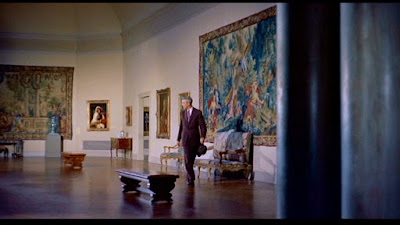Modern usages of classical mythology really interest me.
Artists express various ideas by way of classical mythological allusions all
the time. But, frankly, living in the western United States, I tend to bump
into classical mythological usages a little less often than I do when I go visiting elsewhere. Still, sometimes, they're right under my nose!
On the north side of BYU’s Museum of Art a big abstract
sculpture confronts nearly every visitor. Since I enter on the south side
normally — coming from campus rather than from the parking lot — I experience
that confrontation less often. Last week’s entrance changed that. Visiting the
Norman Rockwell exhibition with my mother and her friend, I was asked “What is
that sculpture?” I didn’t know.
A large abstract bronze sits atop a rectangular pedestal bloc.
It abstraction — if I ever took time in the past to think about the sculpture — had
made me liken the sculpture’s profile to the ridgeline of nearby Provo Peak and
Cascade Mountain, and not so much to the outline of Mt. Timpanogos.
Fortunately, in that moment of maternal interrogation I avoided professorial
guff. I didn’t pretend to know what the sculpture was “doing”. It turns out, it
has nothing to do with the mountain backdrop. The facts are on the bloc’s east
face: “Reuben Nakian, American 1897 – 1986, Juno,
bronze”.
So. Um. It turns out the only thing I actually had right about the sculpture was its
material — bronze.
Its creator is an American… I would have guessed European; maybe
Scandinavian. Wrong. I’d never heard of Reuben Nakian. But the biggest baffler
to me is that, even though I have professed to be interested in classical
mythological usages, this looming bronze has been sitting in front of my museum of art for over 20 years and
its one-word title gives it away as a usage of the myth of Juno, the Roman
sky-goddess!
“I’ve got some work to do!” I confessed to my Mom.
That night I looked through the BYU-MOA on-line materials to
find something scholarly about Nakian’s Juno,
my new nemesis. I found very little, but in about 10 minutes of browsing, I was
able to piece together some elements of apparent truth. So, I am resolved to
learn more about this sculpture and work on it.
What did Reuben
Nakian have in mind when he named this mass of bronze after the Roman
sky-goddess? Did he mean anything by
it? Why call it anything at all? Is it a happenstance that this sculpture got
so named? Did its acquisition at the BYU MOA happen because it’s called Juno?
Here’s what I presently know, listed not necessarily in the
sequence I discovered the details:
The Oxford Guide to
Classical Mythology in the Arts, 1300 – 1990s does NOT list Nakian’s Juno, though it could have, since the
sculpture was created over a decade before the OGCMA was published (1994).
If it were
listed in OGCMA, it would have been
in the article on “Hera” on page 515.
OGCMA0515NOTHera_Nakian
And its entry
would look like this:
Reuben Nakian, “Juno,” abstract sculpture, 1980, Brigham
Young University Museum of Art.
Nakian created many sculptures with titles drawn from
classical mythology. Other titles include “Hecuba”, “Juno: from the Judgement
of Paris”, “Minerva, from the Judgement of Paris”, “Leda and the Swan”, “Nymph
and Seven Dolphins” and others.
“No other sculptor of the twentieth
century has matched Nakian’s heroic grapplings with the grand themes of Western
art, returning classical mythology to the foreground of human consciousness.” Robert
Metzger, cited by Atelier Nakian http://www.nakian.org
When the “Juno” was placed at the
north entrance to the Museum of Art in 1993, an article in the Deseret News included some information
that might be considered authoritative. According to the article, “It
represents an artistic style based in abstract expressionism, yet with a
classical structure that was not embraced by abstract expressionists -
according to Neil Hadlock.”
A summary accompanies it:
“A
sculpture by famed artist Reuben Nakian now graces the entrance to Brigham
Young University's new Museum of Art. The work, an 8x8x8-foot, 4,900-pound
bronze was lifted by crane July 29 onto a pedestal on the east side of the red
granite museum.
Called ``Juno,'' the work was a National Endowment for the Arts commission Nakian
received in 1981. It represents an artistic style based in abstract
expressionism, yet with a classical structure that was not embraced by abstract
expressionists - according to Neil Hadlock. Hadlock, a sculptor and member of
the BYU art faculty, selected the work and oversaw the coloring of the piece at
the Tallix Foundry in New York.”
The Nakian.org website has a plentiful bibliography page,
with articles listed by decade. The Deseret
News article is not listed.
The Nakian Atelier
website lists approximately 100 scholarly works on the artist, Reuben Nakian,
and his artistic production. My next step is to dig into the interesting items
and see whether I can learn something about this work of art. Stay tuned to
Mythmatters, if you care to see this story unfold.
 |
Macfarlane's female relations and a friend pose on 30 Dec 2015 beside
Reuben Nakian's Juno outside the BYU MOA. |
—— RTM




